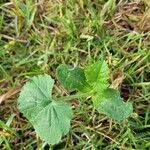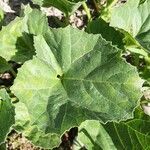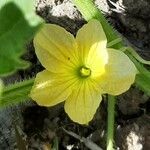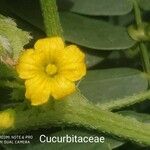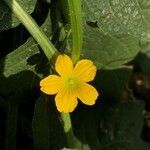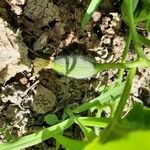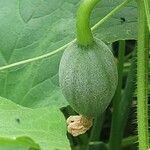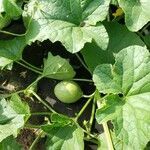Annual climber or trailer to 1.5 m.; stems ± spreading-hairy, hispid or lanate.. Leaf-blade membranous, broadly ovate-or reniform-cordate in outline, ± scabrid-hairy (especially on nerves beneath) or scabrid-punctate, shallowly sinuate-toothed, 26–160 mm. long, 33–200 mm. broad, unlobed or variously palmately 3–5-lobed; lobes usually broad, shallow and rounded, with the central largest, semicircular, broadly ovate or ovate-oblong, rarely elliptic, usually not or but little narrowed towards the base; petiole spreading hispid-hairy, 27–105 mm. long.. Male flowers in 2–4-flowered fascicles; pedicels slender, 3–25 mm. long; receptacle-tube pale green, 3–6 mm. long; lobes linear-lanceolate or filiform, 1–6 mm. long; petals yellow, 5–22 mm. long, 2.5–14 mm. broad, united in lower third.. Female flowers on stalks 3–50 mm. or more long; ovary elliptic to elongate-cylindrical, densely adpressed-pubescent to long-lanate, 5–60 mm. long, 2–6 mm. across; receptacle-tube 2.5–5 mm. long; lobes lanceolate or ovate-lanceolate, 1–6 mm. long; petals 4–19 mm. long, 2–12 mm. broad.. Fruit on a 6–40 mm. or more long stalk, ovoid, bluntly ellipsoid or oblong-ellipsoid, 35–100 mm. long, 20–75 mm. across, in cultivated forms often much larger and sometimes very elongated, variable in colour, sometimes netted, commonly green or striped dark and light green, citron-yellow or orange and with the surface smooth.. Seeds compressed, elliptic in outline, 5–8 × 2.5–4 × 1–1.5 mm.. Fig. 16/8–9, p. 101.
Annual or subperennial (climber or) trailer to 6 m long, plant (woolly) hairy, hirsute or hispid. Leaves: petiole 3-10 cm long; blade ovate or subcircular in outline, 3-15 cm diam., (deeply) lobed or unlobed, mostly hispid, lobes mostly rounded, margin shallowly sinuate-toothed. Male flowers few-fascicled; pedicel 3-25 mm long, hairy; receptacle-tube 4-6 mm long; sepals 1-6 mm long; corolla united in lower third, lobes (narrowly) elliptic, 5-20 by 2.5-15 mm, apex obtuse or occasionally subacute, mostly finely hairy; filaments c. 0.5 mm long, anthers ± included, 1-2(-2.5) mm long, connective with (entire or) 2-lobed apical extension. Female flowers solitary; pedicel 5-30(-50) mm long; ovary ellipsoid, 4-10(-14) mm long, densely fine-hairy, hairs spreading or appressed; sepals 1.5-3(-7) mm long; corolla 8-15(-25) mm long; style 1-2 mm long, stigma 1.5-2.5 mm diameter. Fruit ripening green, yellow, white or brown, plain-coloured, or striped or mottled, globose, (narrowly) ellipsoid or (ob)ovoid, 2-20(-100) by 2-5(-20) cm, smooth; exocarp leathery; mesocarp juicy or carnose; fruiting pedicel 2-4 cm long. Seeds 4-15 by 1-2 mm, usually not winged.
Vines; stems hispid or scabrous. Leaves suborbicular to ovate, 5-15 cm long and wide, shallowly 3-7-lobate, the apex of the lobes rounded, the base cordate, the margin shallowly undulate denticulate, chartaceous, both the surfaces hispid or scabrous; petiole 5-15 cm long, hispid or scabrous. Staminate flowers axillary, fasciculate; peduncle 0.5-2.0 cm long; calyx subcylindrical, lobes 4-6 cm long, subulate, hirsute, green; corolla campanulate, the lobes ca. 1 cm long, yellow, oblong, the apex acute; stamens 6-8 mm long, the anthers 3-4 mm long, the appendix of connective dilated, bilobate; pistillode glandlike. Pistillate flowers in same axils as the staminate flowers; peduncles 1-2 cm long; calyx and corolla as in the staminate flowers; ovary ovoid to subcylindrical, tomentose, the style 1-2 mm long, the stigma forming a spherical head. Fruit variable in color, usually globose, smooth or reticulate, variable in size, glabrous or pubescent; seeds grayish white, oblong, compound, 7-12 mm long, 4-7 mm wide.
Plants creeping. Stems and branches scabrous, puberulent, or hispid. Tendrils filiform, puberulent. Petiole 7-12 cm, setose; leaf blade suborbicular or reniform, 6-15 × 6-15 cm, papery, abaxially hispid, adaxially scabrous, undivided or 3-7-lobed, dentate; sinus truncate or rounded. Plants monoecious or flowers bisexual. Male flowers 1 or 2 to several, fasciculate; pedicels filiform, 0.5-4 cm, pubescent; calyx tube narrowly campanulate, 3-8 mm, densely hispidulous to white villous; segments subulate or linear, 2-4 × 0.4-1.2 mm; corolla yellow; tube 1-2 mm; segments ovate-oblong to broadly ovate or obovate, 3-24 × 2.5-20 mm, obtuse; anther cells flexuous. Female flowers solitary; ovary ellipsoid or fusiform, 4-11 × 2-5 mm, densely white lanate, villous or puberulent; style 1-2 mm; stigmas 3, 2-2.5 mm. Fruit very variable in size, shape, color, odor, and taste. Seeds numerous, yellow-white, ovate-oblong, 4-8 × 2.4-4 mm, smooth, base rounded, apex acute, emarginate. Fl. and fr. May-Sep.
Plants monoecious or andromonoecious, roots thin or with thick, woody rootstock. Tendrils sparsely hispid. Leaves: petiole hispid to hispidulous or retrorsely strigose; blade broadly ovate, unlobed or palmately 3–5-lobed, 2–14(–26) × 2–15(–26) cm, length 0.8–1.3 times width, base cordate, lobes elliptic or oblong to ovate, margins entire or weakly serrate. Inflorescences: pedicels of pistillate flowers and fruits cylindric; staminate flowers 2–7(–18) in fascicles or panicles, <corolla tube 0.8–2 mm>; pistillate flowers: calyx lobes 1.5–3(–8) mm, petals 3.5–9(–20) mm, corolla tube 1–1.6(–3) mm, lobes puberulent or glabrous inside. Pepos tan, yellowish, lemon yellow, light yellowish green, dark green, light orange, monocolor or orange or brown striped, ellipsoid to subglobose [globose, cylindric, ovoid, or obovoid], 2–12(–100) × 2.5–20+ cm, surface netted, warty, scaly, ridged, or smooth, flesh orange to yellowish, green, or whitish. 2n = 24.
Annual; stems to 6 m long, hispid or villous. Leaves ovate; lamina 2–9 cm long, 3–8 cm wide, mostly shallowly to deeply 3–5–lobed; lobes ovate, sinuate-dentate to lobulate, acute or obtuse, rarely unlobed, hispid on both sides; petiole 25–80 mm long, hispid. Male flowers: solitary or in 2–4–flowered fascicles; pedicels 3–25 mm long; hypanthium narrowly campanulate, 3–6 mm long; calyx-lobes subulate or narrowly lanceolate, 1–6 mm long; corolla-lobes ovate, 5–15 mm long, yellow. Female flowers: pedicels 3–30 mm long; ovary ellipsoidal, 5–10 mm long, densely pubescent to villous. Fruit ellipsoidal, 2–5 cm long, 2–4 cm diam., glabrescent or hirsute, green to yellow. Seeds 5–8 mm long.
A pumpkin family plant. It is an annual climber with tendrils. It grows to 0.5 m high and spreads to 1.5 m across. The stems are soft and hairy and often angled. The leaves have lobes and often a wavy or toothed edge. They are on long leaf stalks. The leaves are often hairy underneath. The tendrils are not branched. The flowers are yellow and funnel shaped with expanded lobes. The male flowers occur in clusters and are produced before the female flowers. The fruit is round, mostly with a rough or streaky skin. It is green or yellow inside. The fruit is edible. Different kinds of melons occur. Some have a hard warty scaly skin. Others have a network of fine ridges over the surface.
Leaf-lamina 2·5–8·5(16) × 3–11(20) cm., broadly ovate to reniform in outline, shallowly cordate, sinuate-denticulate, more or less setulose becoming punctate above and beneath, unlobed and broadly rounded or variously usually faintly palmately (3)5—lobed, lobes usually broad, shallow and rounded.
Fruit 2·5–10 × 2–7·5 cm., various, pyriform, ellipsoid, oblong, globose or obpyriform, green with lighter green or yellow stripes becoming yellow when ripe, in cultivated forms often much larger and very variable in size, shape, ornamentation and colour; fruit-stalk 1–8 cm. long.
Prostrate or scandent annual herb, monoecious (male and female flowers on the same plant). Tendrils solitary at each node. Fruit without apically setiferous spines or tubercules. Seeds elliptic in outline, 5-8 x 2.5-4.0 x 1.0-1.5 mm. Flowers yellow or pale apricot-yellow.
male flowers solitary or 2–5 in small sessile or shortly pedunculate fascicles; pedicels 3·5–4·5(25) mm. long, often densely setulose. Receptacle-tube 3–8 mm. long; lobes 1–3·5(6) mm. long. Petals 3–10(22) mm. long, yellow or pale apricot yellow.
Female flowers solitary; pedicel stout, 3–50(80) mm. long; ovary (5)11–16(60) × 2–6 mm., various, often oblong, velutinous; perianth similar to that ofmale flowers.
Seeds 5–8 × 2·5–4 · 1–1·5 mm., elliptic in outline, in cultivated forms often larger.
Annual; stems prostrate or scandent, to 2 m., patent-setulose or hirsute.
Petiole 1·5–8(10·5) cm. long, patent-setulose.
